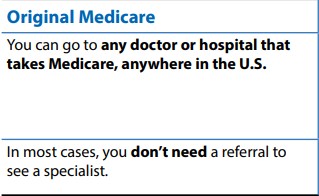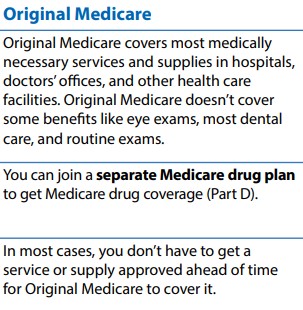Understanding Medicare Advantage And How It Can Help You
When you first sign up for Medicare and during certain times of the year, you can choose how you get your Medicare coverage.
There are 2 main ways to get Medicare:
- Original Medicare is a fee-for-service health plan that has two parts: Part A (Hospital Insurance) and Part B (Medical Insurance). After you pay a deductible, Medicare
pays its share of the Medicare-approved amount, and you pay your share (coinsurance and deductibles). If you want Medicare drug coverage (Part D), you can join a separate Medicare drug plan.
- Medicare Advantage (also known as “Part C”) is a type of Medicare health plan offered by a private company that contracts with Medicare. These plans include Part A, Part B, and usually Part D. Plans may offer some extra benefits that Original Medicare doesn’t cover. Your Medicare health plan decisions affect how much you pay for coverage, what services you get, what doctors you can use, and your quality of care. Learning about your Medicare coverage
choices, getting help from people you trust, and comparing different plans can help you understand all the options available to you.
What are the differences between Original Medicare and Medicare Advantage?
Original Medicare
• Original Medicare includes Medicare Part A (Hospital Insurance) and Part B (Medical Insurance).
• You can join a separate Medicare drug plan to get Medicare drug coverage (Part D).
• You can use any doctor or hospital that takes Medicare, anywhere in the U.S.
• To help pay your out-of-pocket costs in Original Medicare (like your 20% coinsurance), you can also shop for and buy supplemental coverage.

This includes Medicare Supplement Insurance (Medigap). Or, you can use coverage from a former employer or union, or Medicaid.
Medicare Advantage
(also known as Part C)
• Medicare Advantage is a Medicare-approved plan from a private company that offers an alternative to Original Medicare for your health
and drug coverage. These “bundled” plans include Part A, Part B, and usually Part D.
• In most cases, you can only use doctors who are in the plan’s network.
• In many cases, you may need to get approval from your plan before it covers certain drugs or services.
• Plans may have lower out-of-pocket costs than Original Medicare.
• Plans may offer some extra benefits that Original Medicare doesn’t cover—like vision, hearing, and dental services.

Doctor and Hospital Choice


Cost


Coverage


Foreign Travel


Who can join a Medicare Advantage Plan
To join a Medicare Advantage Plan, you must:
• Have Part A and Part B.
• Live in the plan’s service area.
• Be a U.S. citizen or lawfully present in the U.S.
What if I have a pre-existing condition?
You can join a Medicare Advantage Plan even if you have a pre-existing condition.
What if I have End-Stage Renal Disease (ESRD)?
If you have ESRD, you can join a Medicare Advantage Plan during Open Enrollment (October 15–December 7) for coverage starting January 1, during your Initial Enrollment Period when you are first eligible for Medicare, or during a Special Enrollment Period if you qualify for one.
In many Medicare Advantage Plans, you can only use health care providers who are in the plan’s network and service area. Before you join, you may want to check with your providers and the plan you’re considering to make sure the providers you currently see (like your dialysis facility or kidney doctor), or want to see in the future (like a transplant specialist), are in the plan’s network. If you’re already in a Medicare Advantage Plan, check with your providers to make sure they’ll still be part of the plan’s network. Read the plan materials or contact the plan you’re considering for more information.
What if I have other coverage?
Talk to your employer, union, or other benefits administrator about their rules before you join a Medicare Advantage Plan. In some cases, joining a Medicare Advantage Plan might cause you to lose your employer or union coverage for yourself, your spouse, and your dependents and you may not be able to get it back. In other cases, if you join a Medicare Advantage Plan, you may still be able to use your employer or union coverage along with the Medicare Advantage Plan you join. Your employer or union may also offer a Medicare Advantage retiree health plan that they sponsor.
When can you join, switch, or drop Medicare Advantage?
You can only join, switch, or drop a Medicare Advantage Plan during the enrollment periods below:
Open Enrollment Period—Between October 15 and December 7, anyone with Medicare can join, switch, or drop a Medicare Advantage Plan. Your coverage will begin on January 1 (as long as the plan gets your request by December 7). Medicare Advantage Open Enrollment Period—Between January 1 and March 31 of each year, you can make these changes:
- If you’re in a Medicare Advantage Plan (with or without drug coverage), you can switch to another Medicare Advantage Plan (with or without drug coverage).
- You can drop your Medicare Advantage Plan and return to Original Medicare. You’ll also be able to join a separate Medicare drug plan.
During the Medicare Advantage Open Enrollment Period, if you have Original Medicare you can’t:
- Switch to a Medicare Advantage Plan.
- Join a Medicare drug plan.
- Switch from one Medicare drug plan to another.
You can only make one change during the Medicare Advantage Open Enrollment Period, and any changes you make will be effective the first of the month after the plan gets your request. If you’re returning to Original Medicare and joining a separate Medicare drug plan, you don’t need to contact your Medicare Advantage Plan to disenroll. The disenrollment will happen automatically when you join the drug plan. If you already have Part A coverage and you sign up for Part B for the first time between January 1 and March 31 of each year, you can also join a Medicare Advantage Plan at the same time. In this situation, your coverage will start the first of the month after the plan gets your request.
Initial Enrollment Period—When you first become eligible for Medicare, you can join a Medicare Advantage Plan during your Initial Enrollment Period. For many, this is the 7-month period that begins 3 months before the month you turn 65, includes the month you turn 65, and ends 3 months after the month you turn 65. If you’re under 65 and have a disability, you’ll automatically get Part A and Part B after you get disability benefits from Social Security or certain disability benefits from the Railroad Retirement Board for 24 months.
If you sign up during the first 3 months of your Initial Enrollment Period, in most cases, your coverage starts the first day of your birthday month. However, if your birthday is on the first day of the month, your coverage will start the first day of the prior month.
If you join a Medicare Advantage Plan the month you turn 65 or during the last 3 months of your Initial Enrollment Period, your start date for coverage will be delayed.
Note: Beginning January 1, 2023, if you sign up during the last 3 months of your Initial Enrollment Period, your coverage starts the first day of the month after you sign up.
If you join a Medicare Advantage Plan during your Initial Enrollment Period, you can change to another Medicare Advantage Plan (with or without drug coverage) or go back to Original Medicare (with or without a separate Medicare drug plan) within the first 3 months you have Medicare.
Special Enrollment Period—In most cases, if you join a Medicare Advantage Plan, you must keep it for the calendar year starting the date your coverage begins. However, in certain situations, like if you move or you lose other insurance coverage, you may be able to join, switch, or drop a Medicare Advantage Plan during a Special Enrollment Period.
Note: Beginning January 1, 2023, you may be eligible for a Special Enrollment Period to sign up for Medicare (and join a Medicare Advantage Plan) if you miss an enrollment period because of certain exceptional circumstances, like being impacted by a natural disaster or an emergency. Visit Medicare.gov or check with your plan for more information.
What could be costs associated with Medicare Advantage?
Each year, plans set the amounts they charge for premiums, deductibles, and services. The plan (rather than Medicare) decides how much you pay for the covered services you get. The plan may change what you pay only once a year, on January 1st.
You have to pay the Part B premium. In 2022, the standard Part B premium amount is $170.10 (or higher depending on your income). Some people with Social Security benefits pay less ($130 on average).
When calculating your out-of-pocket costs in a Medicare Advantage Plan, in addition to your premium, deductible, copayments, and coinsurance, you should also consider:
- The type of health care services you need and how often you get them.
- Whether you go to a doctor or supplier who accepts assignment. Assignment means that your doctor, provider, or supplier agrees (or is required by law) to accept the Medicare approved amount as full payment for services Medicare covers.
- Whether the plan offers extra benefits (in addition to Original Medicare benefits) and if you need to pay extra to get them.
- Whether you have Medicaid or get help from your state through a Medicare Savings Program to pay your Medicare costs.
- The maximum out-of-pocket limit set by your plan.
What’s the difference between a deductible, coinsurance, copayment, and a maximum out-of-pocket limit?
- Deductible—The amount you must pay for health care or prescriptions before Original Medicare, your Medicare Advantage Plan, your Medicare drug plan, or your other insurance begins to pay.
- Coinsurance—An amount you may be required to pay as your share of the cost for services after you pay any deductibles. Coinsurance is usually a percentage (for example, 20%).
- Copayment—An amount you may be required to pay as your share of the cost for a medical service or supply, like a doctor’s visit, hospital outpatient visit, or prescription drug. A copayment is usually a set amount, rather than a percentage. For example, you might pay $10 or $20 for a doctor’s visit or prescription drug.
- Maximum Out-of-Pocket Limit—The maximum amount you must pay for Part A and Part B covered services if you join a Medicare Advantage Plan.
Types of Medicare Advantage Plans
There are different kinds of MA Plans
• Health Maintenance Organization (HMO) plans
• Preferred Provider Organization (PPO) plans
• Private Fee-for-Service (PFFS) plans
• Special Needs plans (SNPs)
• Medical Savings Account (MSA) plans

